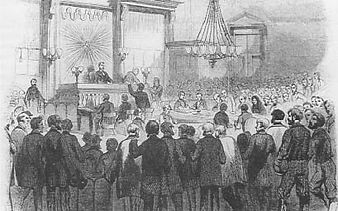The Aftermath
Immediately after Mr. Burdell's body was found, the coroner, John Connery put every resident of the house into house arrest for 14 days in order to examine the body, talk to witnesses and find evidence in No. 31 Bond Street. After 14 days everyone was released from custody except for Emma Cunningham, John Eckel & George Snodgrass. Cunningham & Eckel were charged with the murder of Harvey Burdell and Snodgrass was charged with accessory to murder. The three suspects were housed in The New York Halls of Justice and House of Detention, a.k.a The Tombs, for just over four months prior to Emma Cunningham's trial [1] [6].
The People v. Cunningham began on May 6th, 1857. Andrew Oakley Hall, Stephen B. Cushing, and Charles Edwards represented the people. Henry L. Clinton and Gilbert Dean were the defense attorneys for Emma Cunningham. After over four months of preparation, the actual trial and jury deliberation lasted only three days. Mr. Hall, for the prosecution, argued that Emma Cunningham only married and courted those who would raise her social status. She was inherently painted as someone who fraternized with many men, including John Eckel and George Snodgrass, and argued with Mr. Burdell on many occasions. Mr. Clinton for the defense argued that the prosecution only had circumstantial evidence and Mrs. Cunningham was not able to physically commit the crime due to weakness caused by rheumatism. The defense also bashed Dr. Burdell's character by mentioning an alleged affair between him and his cousin Dimis Hubbard, his gambling history, and his infrequent time spent at No. 31 Bond Street. The defense was successful in proving that all evidence against Cunningham was circumstantial and a jury of all men came back with a not guilty verdict [1].
A jury of all men was called because at this time women were barred from being on a jury due to many reasons. Women were excluded because their primary responsibility was to be taking care of their children. There was worry that they would not be able to handle the details of criminal cases, specifically sex offenses, and that they would be too sympathetic to accuse someone of a crime. Utah became the first state to allow women to serve in 1898, but it took until 1968 for all states to allow women to be on juries. This is important because society at the time had a core belief that women were weaker than men, which in the end helped the defense argue that she could not have committed the crime, but also contributed to the lack of power women had in their relationships, their lives and in their job opportunities [1] [2].
In total, fifty-four witnesses testified. Ten of the witnesses were women and were either housemaids or wives of other witnesses. The remaining men were all professionals. The male witness pool included doctors, policemen, religious leaders, and boarders. They were the decision-makers, did things on their own time, and testified where they were and what they were doing. The women tended to testify about what others were doing at the time of the crime. This witness pool and testaments represented a microcosm of New York at the time, with women being disproportionality represented in the workforce and with their lack of power in society.
After the trial, in an attempt to assert her claim to Burdell's estate when the validity of her marriage was being questioned, Emma Cunningham falsely claimed she was pregnant with his child. She recruited a Dr. Uhl to assist her in this scheme and provide her with a baby to present as Burdell's when the time came for her to "give birth," a choice she would come to regret as he double crossed her and informed the district attorney of her plans. With the district attorney in on the ruse, the scheme was carried out, with Emma Cunningham going so far as to imitate the screams of child birth behind a closed door. At this time, the police arrived at the hospital and charged Mrs. Cunningham with fraud. The charges were later dropped, but the ordeal was enough to completely invalidate any claims she had to Burdell's estate [3].

[ ] Illustration of John Eckel's Cell. From, "Frank Leslie's Illustrated Newspaper" 16 May, 1857.

[4 ] Illustration of Emma Cunningham's Cell. From, "Frank Leslie's Illustrated Newspaper" 16 May, 1857.

[5 ] Harper's Weekly, 1857. Illustration of the courtroom and spectators.

[7] Frank Leslie's Illustrated Newspaper, 1857. Drawing of the room where it happened.


[8] Frank Leslie's Illustrated Newspaper, 1857. The dagger and stained shirt presented as evidence in trial.
1. The People v. Cunningham (1857), https://cite.case.law/park-crim-rep/6/398/
2. McDonald, Laughlin. “A Jury of One’s Peers”. ACLU.org. March18, 2011. https://www.aclu.org/blog/smart-justice/mass-incarceration/jury-ones-peers
3. “The Bond Street Tragedy,” Murder by Gaslight, accessed December 1, 2020, http://www.murderbygaslight.com/2011/03/bond-street-tragedy.html.
4. Illustration of Emma Cunningham's Cell. From, "Frank Leslie's Illustrated Newspaper" 16 May, 1857
5. Harper's Weekly, 1857. Illustration of the courtroom and spectators. https://law.jrank.org/pages/2547/Emma-Cunningham-Trail-1857.html#google_vignette
6. Ellen Horan. “The Story Behind the Story: ‘31 Bond Street,’ by Ellen Horan”, RapSheet (blog), March 30, 2010. http://therapsheet.blogspot.com/2010/03/story-behind-story-31-bond-street-by.html
7. "Scenes from the Burdell Murder," Murder by Gaslight, accessed December 1, 2020, http://www.murderbygaslight.com/2013/12/scenes-from-burdell-murder.html
8. "Scenes from the Burdell Murder," Murder by Gaslight, accessed December 1, 2020, http://www.murderbygaslight.com/2013/12/scenes-from-burdell-murder.html